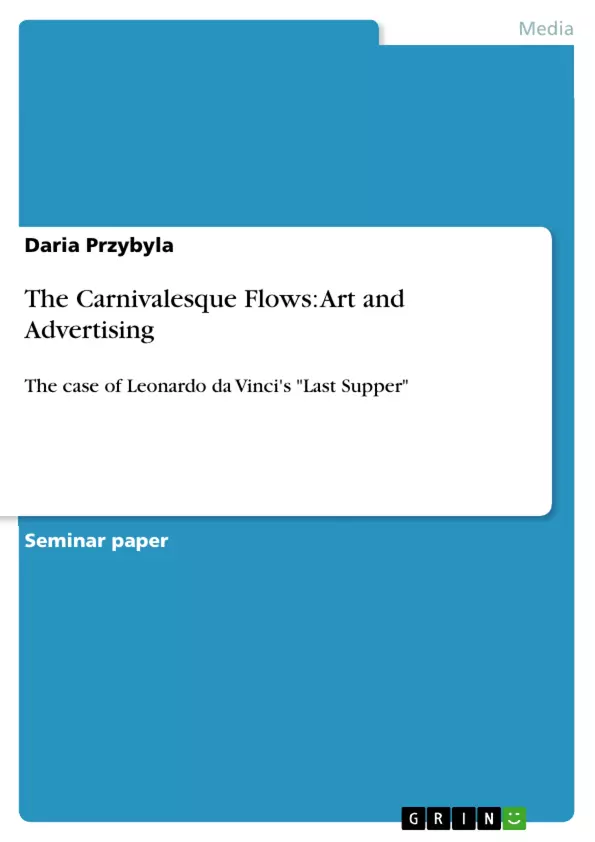Bakhtinian conception of the carnivalesque is very complex in the sense that it opens a way toward a more general depiction of the nature of art in the relation to the repressed instincts of humans. Even though the idea is situated mostly in medieval and renaissance context, it can be easily transported and/or observed in contemporary popular culture. The theme that I intend to elaborate on is a mode of public relations encoded in media advertising and communicated via visual representations that extends far beyond hegemonic policies. There are two issues that should be pinpointed with respect to the subject matter. First, the master-narratives of culture and religion, as will be illustrated in the following argument, prove to have each a different relationship with the elements of the carnivalesque. And second, as we shall see, the clash between the religious ‘high’, sanctified art and the ‘low’ by-product of social development results in a tension between competing discourses. Consequently, the dialogic interaction within the framework of popular culture between the religious and the cultural reinforces import of the carnivalesque. The following essay concentrates on the case of Leonardo da Vinci's Last Supper and the way in which the painting has been used in popular culture along with an analysis of reasons for controversies arising around such cultural practices.
Table of Contents
- Bakhtinian conception of the carnivalesque
- The discrepancy between the variety of social communities and the unified constraints imposed by religious authority
- The problem of religion is decentred by the question of civilisation
- The boundaries between work and leisure, art and advertising as well as the spheres of sacrum and profanum have been so overwhelmingly relativised
- The shift in temporal discernment
- Using da Vinci's drawing I would like to point to some sexual predicaments of the carnivalesque
Objectives and Key Themes
This text examines the Bakhtinian conception of the carnivalesque and its application to contemporary media advertising. The main goal is to explore the relationship between religious and cultural discourses within the framework of popular culture.
- The carnivalesque as a subversive force in challenging established hierarchies and authority.
- The tension between religious 'high' art and 'low' cultural products in contemporary society.
- The role of advertising in manipulating and subverting cultural norms and values.
- The ongoing debate about blasphemy in the context of artistic expression.
- The redefinition of the concept of profanation within the context of contemporary values.
Chapter Summaries
The text begins by outlining Bakhtin's theory of the carnivalesque and its relevance to contemporary culture. It argues that the carnivalesque serves as a subversive force against dominant power structures, particularly religious authorities. The text then discusses the tension between religious 'high' art and 'low' cultural products, exemplified by the controversy surrounding a Marithe et Francois Girbaud advertisement that was banned for its perceived profanation of Leonardo da Vinci's "Last Supper."
The author goes on to analyze the role of advertising in manipulating cultural norms and values, particularly in the context of blasphemy. He argues that the clash between religion and culture creates fertile ground for misinterpretation and the manipulation of religious sensitivities for commercial gain. This tension is further explored through an examination of the ways in which advertising strategies employ elements of the carnivalesque to provoke emotions and draw attention.
The text concludes with a discussion of the shifting nature of religion and its impact on contemporary culture. The author emphasizes the ongoing debate about the limits of artistic expression and the boundaries between religious and cultural domains.
Keywords
The primary focus of this text is the Bakhtinian conception of the carnivalesque, its application to contemporary media advertising, and the resulting tension between religious and cultural discourses. Key concepts include: carnivalesque, religious authority, cultural norms, advertising, blasphemy, profanation, artistic expression, and the interplay between religion and culture in the modern world.
- Quote paper
- Master of Arts Daria Przybyla (Author), 2006, The Carnivalesque Flows: Art and Advertising, Munich, GRIN Verlag, https://www.grin.com/document/77233



